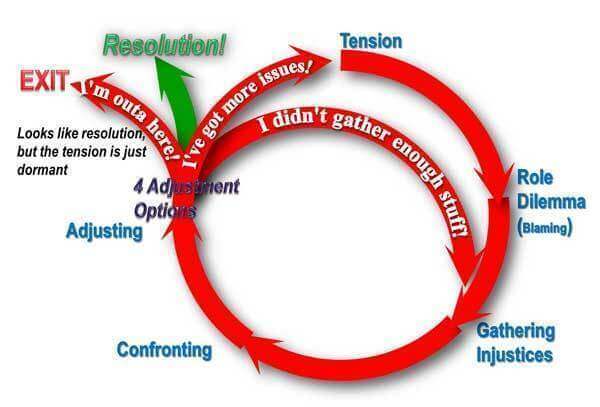If you fear conflict, it is most likely because you have a wrong view. The conflict cycle creates much of the dread and negative emotions. Most people fear conflict and see it as something they have no desire to participate in. Without good skills and a proper view of conflict, it turns into a joy robbing, repeating pattern. If you adopt a different view of conflict and work on your skills, you can get out of the cycle and find solutions.
Of course, you can leave the conflict cycle at any time, but if you end up at step 5, it automatically requires resolution or repetition. Obviously, conflict between individuals impacts the team or group and productivity.

So, let's look at each step or phase to understand what is happening. For now, we will not discuss resolving conflict in this communication; we will discuss what makes up the conflict cycle.
Tension
The conflict cycle starts with tension! Something isn't right between you and the other person(s). Multiple items create the tension, but it is often about someone not getting their way.
Conflicts can easily arise from...
- Differences - culture, goals, desires, etc.
- Power - how it is defined, how it is used
- Needs - ignored, blocked, confused, incompatible
- Perceptions - about self, about others, about the situation, about threat
- Emotions - how it feels, not how it is, expressed emotions, suppressed emotions
- Values and Principles - unclear values for either or both parties; assume it is about preferences; assume it is about principles and values
The list is much longer because tension can be created about anything.
Role Dilemma
This can be more easily understood if you think about "blaming." The tension has been created, and now someone needs to be blamed. For example, someone didn't follow through with their job or responsibility, which is why we are in this mess right now! And that someone is not ME! Most likely, it's YOU!
So, the tension escalates because it is becoming more emotional. Instead of using the situation to learn and grow, it becomes a battlefield to prove that you are right and they are wrong.
Gathering Injustices
To prove that the blame is accurate, you look for the facts to support your case. Both parties begin their research about the tension and role dilemma to prove the other person is wrong.
"Justice" must prevail, and with enough facts or enough talk, the blame will be assigned "correctly," and it won't be on you!
Confronting
With the injustices gathered, you confront each other to see who will win. You will soon see who has the best argument or the most skill to overcome the opposing arguments. If you know your preferred conflict style, this is the time you will use it.
If you know more about conflict and the conflict cycle, you will use the appropriate style for the situation. (If you want to know about your conflict styles, please contact us to take the Thomas-Kilman Conflict Mode Instrument.)
Adjusting
At some point in the confrontation, you move into the adjustment phase. There are at least four options in this phase.
I've Got More Issues
Often, the adjustment provides an opportunity to drag other unresolved issues into this conflict. That allows either of you to return to the beginning with "I've got more issues!" Doing that adds even more tension to the situation.
I Didn't Gather Enough Stuff
Another option is skipping tension and role dilemma and landing back at gathering more injustices. That is like a time out in a sports event: "Time out, we will reconvene to fight more later." Now, both sides can gather more facts to support their position.
I'm Outa Here!
Worse, you decide to separate from each other without any resolution. Many people do this because there is some relief in not dealing with the conflict. The separation may be short or lengthy. The problem is that you have adopted the EXIT strategy instead of pushing to get a resolution.
The EXIT strategy is deceptive. It can appear to be a resolution, but it isn't. When you choose EXIT, you put the unresolved issue in the closet. It isn't resolved; it is just dormant - for now. It most often gets pulled out to support some other conflict you have.
Resolution!
The best option for the confronting step is actually to find a RESOLUTION. Unfortunately, resolution requires effort, and it isn't fun much of the time.
Now that you know the elements of the Conflict Cycle, start finding a resolution so that you can get out of the cycle!
